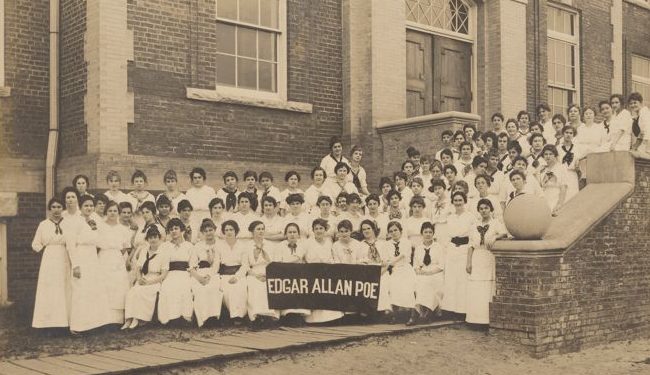
The Edgar Allan Poe Literary Society, established in 1910, was one of the first student organizations founded at East Carolina Teachers Training School. Along with the Sidney Lanier Society, it was organized at the request of female students, and by its charter was specifically for young women. Earlier, the Jarvis Society had been founded at the request of male students. As male enrollment diminished, however, so did that society. Every student at the Training School was expected “to join and take an active part in one of these societies.” While vying with one another, the Poe and Lanier often worked cooperatively in organizing projects for the Training School and later the Teachers College.
According to Training School publications, these societies sought “to encourage social intercourse among the students, to put into practice the knowledge gained in the class rooms, through oral and written discussions, and to attain proficiency in parliamentary usage.” They also did “much toward unifying the student body and encouraging school spirit.” Moreover, the societies sought “to further the mental, moral, and social development of its members and to create a greater love for the best in literature, music, and art.”
Working together, the Poe and Lanier societies had portraits of Governor Thomas J. Jarvis and Professor William Henry Ragsdale painted for presentation to the Training School. The societies staged two performances, Mr. Bob in 1912 and The Mikado in 1913, to raise funds to pay for the portraits. During the 1913 commencement ceremonies, Poe and Lanier presented the portraits of the two founding fathers to the Training School. The same year, the societies established a new campus tradition, that of inter-society debates. The Poe won the first, on “Woman Suffrage in North Carolina,” arguing the affirmative. In the spring of 1913, the two societies organized a May Day program which promptly became a campus tradition through the Teachers College era.
The Poe Society excelled in organizing campus events. In 1914, it staged Hiawatha, a “pageant play” based on Henry Wadsworth Longfellow’s (1807-1882) epic poem. Nearly every member was involved in the production, either on stage or behind the scenes. In 1919, the Poe presented a “Colonial Evening” program coinciding with George Washington’s birthday, which featured Washington’s capture of Hessian forces at Trenton. The year before, the Poe sponsored a “Victory Celebration” on campus featuring a guest speaker and the presentation of a handsome American flag to the Training School. The Poe and Lanier Societies, both named after Southern writers, had members serve as student editors of the Training School Quarterly, the flagship publication of the school. In 1921, the Poe Society gave the Training School a unique gift: a “moving picture outfit.” Thereafter, weekly pictures were shown on Saturday evenings. The campus attractions included Les Misérables, Macbeth, Lorna Doone, The Raven, and Napoleon and Josephine. Through the movie projector, the Poe Society added a new, technologically modern dimension to campus culture, introducing the campus to one of the most globally pervasive forms of popular culture in the twentieth century.
The Poe Society also contributed to the popularity of Jim Crow culture on campus. In the spring of 1921, the Poe partnered with the Greenville High School boys as sponsors of the boy’s performance of their minstrel show, “Black Beauty Minstrels.” The first performance was so popular that the Poe Society sponsored an encore the following evening.
In October 1926, an additional society, the Emerson, was added to the competition. The Emerson Society participated in a series of one-act plays with the Poe and Lainer Societies. The three literary societies also sponsored the May Day Program. In October 1926, an additional society, the Emerson, was established. The Emerson Society participated in a series of one-act plays with the Poe and Lainer Societies. The three literary societies also sponsored the May Day Program. Still, the Poe Society remained, through the 1930s, the strongest of the traditional groups, regularly sponsoring dances and other social events on campus. The Poe Society continued until shortly after WWII when an influx of men to campus, plus increasing diversification of school clubs, organizations, and activities diminished its appeal. Unlike the Training School era, participation in one of the societies was no longer required. Throughout its three decade history, it was one of the most dynamic student organizations, orchestrating major cultural events annually that entertained the campus and the community.
Sources
- “Annual Intersociety Debate was held Saturday Night.” Greenville News. April 14, 1919. P. 1.
- “Beautiful Pageant-Play Given in Greenville.” The Daily Free Press (Kinston, N.C.). December 11, 1914. P. 3.
- “Black Beauty Minstrel Pleases.” Greenville News. April 5, 1921. P. 1.
- Edgar Allan Poe Literary Society, 1911-1938. University Archives # UA45-04. J. Y. Joyner Library. East Carolina University. Greenville, N.C.
- “Literary Societies.” Second Annual Catalogue of the East Carolina Teachers Training School. Greenville, N.C.: The Reflector Co., 1911. P. 15.
- “Literary Societies.” Training School Quarterly. Vol. 1, no. 1. April, May, June 1914. Raleigh: Edwards & Broughton Printing Co. 1914. Pp. 49-50.
- Muffly, May R. B. “Hiawatha Indian Pageant-Play.” Training School Quarterly. Vol. 1, no. 4. January, February, March 1915. Raleigh: Edwards & Broughton Printing Co. 1915. Pp. 213-215.
- “New Society Emerson.” The Teco Echo. October 12, 1926. P. 1. https://digital.lib.ecu.edu/37815.
- A Program of One-Act Plays Presented by the Emerson, Lanier, and Poe Societies. November 24, 1939. https://digital.lib.ecu.edu/24184.
- "Societies Hold May Court of ECTC Campus this Afternoon." The Techo Echo. May 5, 1945. https://digital.lib.ecu.edu/10694.
- “The Edgar Allan Poe Literary Society.” Training School Quarterly. Vol, 8, no. 3. April, May, June 1921. Pp. 274-275.
- “The Mikado a Hit.” The Wilmington Dispatch (Wilmington, N.C.). December 20, 1912. P. 2.
Citation Information
Title: Literary Societies
Author: John A. Tucker, PhD
Date of Publication: 7/18/2019